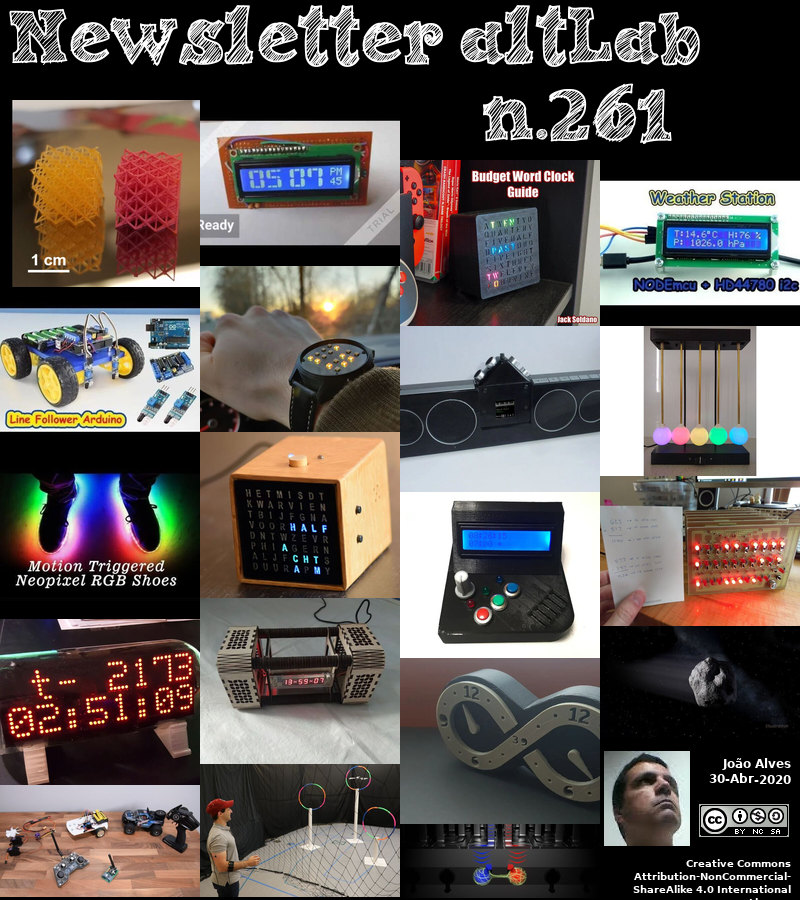2020-04-30 - Nº 261
Editorial
Esta é a Newsletter Nº 261 que se apresenta com o mesmo formato que as anteriores. Se gostar da Newsletter partilhe-a!
Todas as Newsletters encontram-se indexadas no link.
Esta Newsletter tem os seguintes tópicos:
Faz hoje anos que nascia, em 1777, o matemático alemão Carl Friedrich Gauss. Ele foi responsável pela transformação de quase todas as áreas da matemática, para as quais o seu talento mostrou-se desde muito cedo. Pelas suas contribuições à teoria do magnetismo e da electricidade, uma unidade de campo magnético foi denominada de gauss. Ele criou o método dos mínimos quadrados na estatística, e sua curva de erro gaussiana permanece bem conhecida. Ele antecipou o sistema SI na sua proposta de que as unidades físicas deveriam basear-se em algumas unidades absolutas, como comprimento, massa e tempo. Em astronomia, ele calculou as órbitas dos pequenos planetas Ceres e Pallas por um novo método. Ele inventou o heliotrópio para determinação trigonométrica da forma da Terra. Com Wilhelm Weber, ele desenvolveu um telégrafo electromagnético e dois magnetómetros.
Faz igualmente anos hoje que nascia, em 1904 o matemático norte-americano George Robert Stibitz. Foi considerado por muitos como o "pai do computador digital moderno". Enquanto trabalhava como matemático de pesquisa nos Laboratórios Bell Telephone, em Nova York, Stibitz trabalhou no equipamento de comutação de relé usado nas redes telefónicas. Em 1937, Stibitz, cientista do Bell Laboratories, construiu uma máquina digital baseada em relés, lâmpadas de lanterna e tiras de metal cortadas de latas. Ele o chamou de "Modelo K" porque a maior parte foi construída na sua mesa da cozinha. Ele trabalhou com o princípio de que, se dois relés fossem activados, eles causariam a activação de um terceiro, onde esse terceiro relé representaria a soma da operação. Além disso, em 1940, ele fez uma demonstração da primeira operação remota de um computador.
Por fim, faz anos hoje que nascia, em 1916 o matemático, engenheiro electrotécnico e criptógrafo norte-americano Claude Shannon. Conhecido como "o pai da teoria da informação". Shannon é conhecido por ter fundado a teoria da informação com um artigo de referência, "Uma teoria matemática da comunicação", que ele publicou em 1948. Ele também é creditado por ter fundado a teoria do desenho de computadores digitais e de circuitos digitais em 1937, quando, como estudante de mestrado de 21 anos no Instituto de Tecnologia de Massachusetts (MIT), escreveu sua tese demonstrando que as aplicações eléctricas da álgebra booleana poderia construir e resolver qualquer relacionamento numérico lógico. Shannon contribuiu para o campo da cripto-análise para defesa nacional durante a Segunda Guerra Mundial, incluindo seu trabalho básico sobre decifrar códigos e telecomunicações seguras.
Nesta semana que passou ficámos a saber que o asteróide 1998 OR2 passou muito perto da Terra, a cerca de 6.3 milhões de quilómetros que corresponde a cerca de mais de 16 vezes a distância à Lua. Este corpo celeste tem cerca de 2 quilómetros de diâmetro e foi descoberto em Julho de 1998 pelo o Jet Propulsion Lab da NASA.
Também nesta semana que passou foi lançada a distribuição Fedora 32. As três edições - Workstation, Server e CoreOS - foram lançadas em simultâneo e trazem como grandes novidades o refrescamento das principais linguagens de programação e bibliotecas de sistema, incluindo o GCC 10, o Ruby 2.7 e o Python 3.8. Foi igualmente feito um esforço para que as bibliotecas de Python 2 e as suas dependências sejam removidas.
E nesta semana que passou também foram comemorados os 30 anos do Hubble. As imagens icónicas e avanços científicos do Telescópio Espacial Hubble da NASA / ESA redefiniram nossa visão do Universo. A 24 de Abril de 1990, o Telescópio Espacial Hubble foi lançado no Space Shuttle Discovery, junto com uma equipa de cinco astronautas. Implantado na órbita baixa da Terra um dia depois, o telescópio abriu nossos olhos para o cosmos e transformou nosso conhecimento colectivo do Universo.
Também esta semana foi lançada uma nova câmara para o Raspberry PI. A câmara de alta qualidade de 12.3 megapixels, custa cerca de 50€. A principal novidade, além do aumento de qualidade é a possibilidade de ser acoplado de forma simples um conjunto de lentes intercambiáveis. Esta câmara vem equipada com o sensor IMX477 da Sony.
Na Newsletter desta semana apresentamos diversos artigos científicos assim como projetos de maker. São apresentadas a revista neweletronics de 28 de Abril e a MagPI nº93 de Maio de 2020.
 João Alves ([email protected])
João Alves ([email protected])
O conteúdo da Newsletter encontra-se sob a licença  Creative Commons Attribution-NonCommercial-ShareAlike 4.0 International License.
Creative Commons Attribution-NonCommercial-ShareAlike 4.0 International License.
Novidades da Semana

Asteroid 1998 OR2 to Safely Fly Past Earth This Week
"A large near-Earth asteroid will safely pass by our planet on Wednesday morning, providing astronomers with an exceptional opportunity to study the 1.5-mile-wide (2-kilometer-wide) object in great detail. The asteroid, called 1998 OR2, will make its closest approach at 5:55 a.m. EDT (2:55 a.m. PDT). While this is known as a "close approach" by astronomers, it's still very far away: The asteroid will get no closer than about 3.9 million miles (6.3 million kilometers), passing more than 16 times farther away than the Moon. Asteroid 1998 OR2 was discovered by the Near-Earth Asteroid Tracking program at NASA's Jet Propulsion Laboratory in July 1998, and for the past two decades astronomers have tracked it. As a result, we understand its orbital trajectory very precisely, and we can say with confidence that this asteroid poses no possibility of impact for at least the next 200 years. Its next close approach to Earth will occur in 2079, when it will pass by closer - only about four times the lunar distance." [...]

Fedora 32 is officially here!
"It’s here! We’re proud to announce the release of Fedora 32. Thanks to the hard work of thousands of Fedora community members and contributors, we’re celebrating yet another on-time release. If you just want to get to the bits without delay, head over to https://getfedora.org/ right now. For details, read on! All of Fedora’s Flavors Fedora Editions are targeted outputs geared toward specific “showcase” uses." [...]

Hubble Celebrates Its 30th Anniversary With A Tapestry Of Blazing Starbirth
"The NASA/ESA Hubble Space Telescope’s iconic images and scientific breakthroughs have redefined our view of the Universe. To commemorate three decades of scientific discoveries, this image is one of the most photogenic examples of the many turbulent stellar nurseries the telescope has observed during its 30-year lifetime. The portrait features the giant nebula NGC 2014 and its neighbour NGC 2020 which together form part of a vast star-forming region in the Large Magellanic Cloud, a satellite galaxy of the Milky Way, approximately 163 000 light-years away. The image is nicknamed the 'Cosmic Reef' because it resembles an undersea world. On 24 April 1990, the Hubble Space Telescope was launched on the Space Shuttle Discovery, along with a five-astronaut crew. Deployed into low Earth orbit a day later, the telescope has since opened our eyes to the cosmos and transformed our collective knowledge of the Universe." [...]

Raspberry Pi High Quality Camera on sale now at $50
"We’re pleased to announce a new member of the Raspberry Pi camera family: the 12.3-megapixel High Quality Camera, available today for just $50, alongside a range of interchangeable lenses starting at $25. It’s really rather good, as you can see from this shot of Cambridge’s finest bit of perpendicular architecture. Features include: - 12.3 megapixel Sony IMX477 sensor - 1.55μm × 1.55μm pixel size – double the pixel area of IMX219 - Back-illuminated sensor architecture for improved sensitivity - Support for off-the-shelf C- and CS-mount lenses - Integrated back-focus adjustment ring and tripod mount We expect that over time people will use quite a wide variety of lenses, but for starters our Approved Resellers will be offering a couple of options: a 6 mm CS‑mount lens at $25, and a very shiny 16 mm C-mount lens priced at $50. " [...]
Outras Notícias
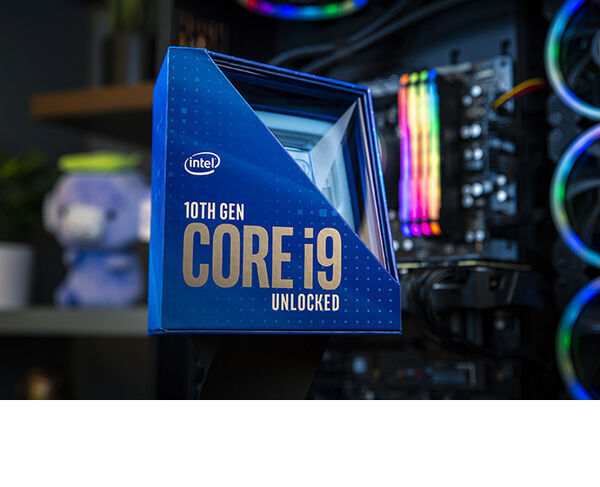
Intel Delivers World’s Fastest Gaming Processor
"Intel introduced today the 10th Gen Intel® Core™ S-series desktop processors, including Intel’s flagship Core i9-10900K processor, the world’s fastest gaming processor1. With speeds reaching up to a maximum of 5.3 GHz with Intel® Thermal Velocity Boost2 out of the box, 10th Gen Intel Core desktop processors deliver real-world performance for a new level of experience in gaming. “Intel is committed to enabling the future of powerful desktop gaming by continuously pushing the performance boundary to deliver an amazing PC gaming experience. The 10th Gen Intel Core S-series for desktops, and the Intel Core i9-10900K processor, the world’s fastest gaming processor reinforces our commitment to the gaming and enthusiast communities.” – Brandt Guttridge, Intel senior director of the Desktop Products Group Why It’s Great for Gaming and Overclocking: At the top of the stack is the unlocked 10th Gen Intel Core i9-10900K, the world’s fastest gaming processor1, featuring up to 10 cores, 20 threads and DDR4-2933 memory speeds. The i9-10900K processor powers the ultimate gaming experience, allowing more tuning control, faster multitasking and smoother gameplay. The new Intel® Turbo Boost Max Technology 3.0 provides automatic performance boosts on lightly threaded applications, while per-core hyperthreading control allows experienced overclockers to decide which threads to turn on or off on a per-core basis." [...]

Spitzer Telescope Reveals the Precise Timing of a Black Hole Dance
"Black holes aren't stationary in space; in fact, they can be quite active in their movements. But because they are completely dark and can't be observed directly, they're not easy to study. Scientists have finally figured out the precise timing of a complicated dance between two enormous black holes, revealing hidden details about the physical characteristics of these mysterious cosmic objects. The OJ 287 galaxy hosts one of the largest black holes ever found, with over 18 billion times the mass of our Sun. Orbiting this behemoth is another black hole with about 150 million times the Sun's mass. Twice every 12 years, the smaller black hole crashes through the enormous disk of gas surrounding its larger companion, creating a flash of light brighter than a trillion stars - brighter, even, than the entire Milky Way galaxy." [...]

Micron Unveils World’s First Open-Source Storage Engine Designed for SSDs and Storage Class Memory
"Micron Technology, Inc. (Nasdaq: MU), today announced the first open-source, heterogeneous-memory storage engine (HSE), designed specifically for solid-state drives (SSDs) and storage-class memory (SCM). Legacy storage engines born in the era of hard disk drives (HDDs) failed to architecturally provide for the increased performance and reduced latency of next-generation nonvolatile media. HSE, originally developed by Micron and now available to the open-source community, is ideal for developers using all-flash infrastructure who require the benefits of open-source software, including the ability to customize or enhance code for their unique use cases. “As the only company developing storage class memory, flash and DRAM technologies, Micron is uniquely positioned to build a software stack that accelerates applications running in today’s flash-based storage environments as well as storage class memory-based infrastructure of the future,” said Derek Dicker, corporate vice president and general manager of the Storage Business Unit at Micron. “We have delivered a first-of-its-kind innovation for open-source storage developers, unlocking the full potential of high-performance storage applications.” In addition to delivering performance and endurance improvements, HSE reduces latency, especially for large-scale data sets, through intelligent data placement. HSE improves throughput of particular storage applications by up to six times, reduces latency 11 times1 and improves SSD endurance by seven times." [...]

VESA releases updated DisplayPort Alt Mode spec to bring DisplayPort 2.0 performance to USB4™ and new USB Type-C® devices
"The Video Electronics Standards Association (VESA®) today announced that it has released version 2.0 of the DisplayPort™ Alternate Mode (“Alt Mode”) standard. DisplayPort Alt Mode 2.0 provides seamless interoperability with the new USB4™ specification published by the USB Implementers Forum (USB-IF), and fully enables all of the features in the latest version of the DisplayPort standard (version 2.0) through the USB Type-C® (USB-C) connector. With DisplayPort Alt Mode, the USB-C connector can transmit up to 80 Gigabits per second (Gbps) of DisplayPort video data utilizing all four high-speed lanes in the cable, or up to 40 Gbps with simultaneous SuperSpeed USB data delivery. VESA anticipates first products incorporating DisplayPort Alt Mode 2.0 to appear on the market in 2021. DisplayPort 2.0, which was introduced in June 2019, provides up to a 3X increase in data bandwidth performance compared to the previous version of DisplayPort, as well as new capabilities to address future performance requirements of displays. These include beyond-8K resolutions, higher refresh rates and high dynamic range (HDR) support at higher resolutions, improved support for multiple display configurations, as well as improved user experience with augmented/virtual (AR/VR) displays, including support for 4K-and-beyond VR resolutions." [...]

Artificial Intelligence Cannot Be Inventors, US Patent Office Rules
"On Monday, the United States Patent and Trademark Office published a decision that claims artificial intelligences cannot be inventors. Only “natural persons” currently have the right to get a patent. Last year, two relatively mundane patents—one for a shape-shifting food container and another for an emergency flashlight—posed an existential question for international patent regulations around the world: Does an inventor have to be a human? These two inventions were the work of DABUS, an artificial intelligence system created by physicist and AI researcher Stephen Thaler. Now, the USPTO has decided that DABUS and any other AI cannot be listed as an inventor on a patent filing. Until now, US patent law was vague about whether machines could invent, referring to “individuals” as eligible inventors." [...]

Elon Musk says Starlink internet private beta to begin in roughly three months, public beta in six
"SpaceX CEO and founder Elon Musk has shared more details about when in 2020 we can expect the company’s Starlink low-latency, high-bandwidth satellite internet service to actually be available to customers. He said on Twitter that a private beta for Starlink would begin in around three months, with a public beta to kick off roughly three months after that. The initial beta test will apply to those located in “high latitudes,” Musk added. To date, SpaceX has said that Starlink service will initially be made available to customers in Canada and in the northern United States in 2020, with additional service expansion to follow to other parts of the world throughout 2021. On Twitter in response to a question about whether Germany counts as “high latitude,” Musk said that it does, indicating beta service at least may be available in more markets than the U.S. and Canada ahead of next year. Late last year, Musk tweeted saying he was using a Starlink satellite connection to do so, and since then the company has launched six batches of 60 satellites each to build out its network." [...]
Ciência e Tecnologia
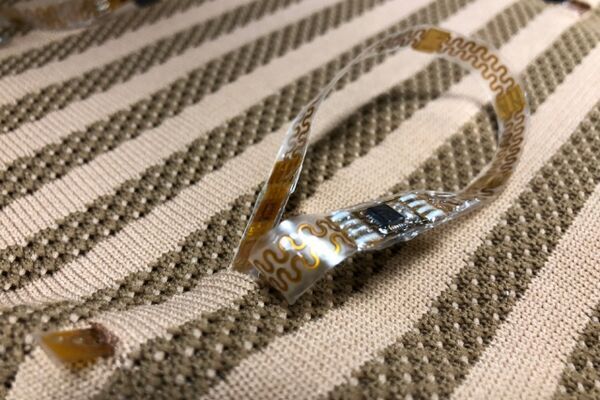
Sensors woven into a shirt can monitor vital signs
"Comfortable, form-fitting garments could be used to remotely track patients’ health. MIT researchers have developed a way to incorporate electronic sensors into stretchy fabrics, allowing them to create shirts or other garments that could be used to monitor vital signs such as temperature, respiration, and heart rate. The sensor-embedded garments, which are machine washable, can be customized to fit close to the body of the person wearing them. The researchers envision that this type of sensing could be used for monitoring people who are ill, either at home or in the hospital, as well as athletes or astronauts. “We can have any commercially available electronic parts or custom lab-made electronics embedded within the textiles that we wear every day, creating conformable garments,” says Canan Dagdeviren, the LG Electronics Career Development Assistant Professor of Media Arts and Sciences at MIT. “These are customizable, so we can make garments for anyone who needs to have some physical data from their body like temperature, respiration rate, and so forth.” Dagdeviren is the senior author of a paper describing the new material today in the journal npg Flexible Electronics." [...]

Muscle signals can pilot a robot
"CSAIL's Conduct-A-Bot system uses muscle signals to cue a drone’s movement, enabling more natural human-robot communication. Albert Einstein famously postulated that “the only real valuable thing is intuition,” arguably one of the most important keys to understanding intention and communication. But intuitiveness is hard to teach — especially to a machine. Looking to improve this, a team from MIT’s Computer Science and Artificial Intelligence Laboratory (CSAIL) came up with a method that dials us closer to more seamless human-robot collaboration. The system, called “Conduct-A-Bot,” uses human muscle signals from wearable sensors to pilot a robot’s movement. “We envision a world in which machines help people with cognitive and physical work, and to do so, they adapt to people rather than the other way around,” says Professor Daniela Rus, director of CSAIL, deputy dean of research for the MIT Stephen A. Schwarzman College of Computing, and co-author on a paper about the system." [...]

Quantum electrodynamics experiment
"Researchers see application in future quantum technologies The fundamental laws of physics are based on symmetries that, among other things, determine the interactions between charged particles. Using ultracold atoms, researchers at Heidelberg University have experimentally constructed the symmetries of quantum electrodynamics. They hope to gain new insights for implementing future quantum technologies that can simulate complex physical phenomena. The results of the study were published in the journal “Science”. The theory of quantum electrodynamics deals with the electromagnetic interaction between electrons and light particles. It is based on so-called U(1) symmetry, which for instance specifies the movement of particles." [...]
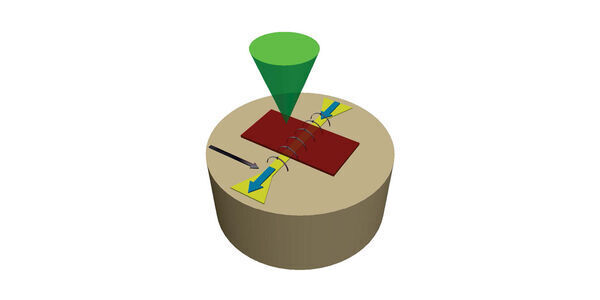
Bose-Einstein condensate: magnetic particles behave repulsively
"New findings by physicists from Münster University may be relevant for future information technologies / Study in "Nature Communications" Data transmission that works by means of magnetic waves instead of electric currents – for many scientists, this is the basis of future technologies that will make transmission faster and individual components smaller and more energy-efficient. Magnons, the particles of magnetism, serve as moving information carriers. Almost 15 years ago, researchers at the University of Münster succeeded for the first time in achieving a novel quantum state of magnons at room temperature – a Bose-Einstein condensate of magnetic particles, also known as a "superatome", i.e. an extreme state of matter that usually occurs only at very low temperatures. Since then, it has been noticeable that this Bose-Einstein condensate remains spatially stable – although the theory predicted that condensate of magnons, which are attractive particles, should collapse. In a recent study, the researchers have now shown for the first time that the magnons within the condensate behave in a repulsive manner, which leads to the stabilization of the condensate." [...]

FSU researchers discover new structure for promising class of materials
"Florida State University researchers have discovered a novel structure for organic-inorganic hybrid materials that shows potential for more efficient technologies. Professor of Chemistry and Biochemistry Biwu Ma and his team have published a new study in the journal Science Advances that explains how they created a hollow nanostructure for metal halide perovskites that would allow the material to emit a highly efficient blue light. Metal halide perovskites are a material that have shown great potential for photon-related technologies such as light-emitting diodes and lasers, but scientists have still been working to make them more efficient and effective. “The fabrication of new generation color displays and solid-state lighting requires luminescent materials and devices of the three primary colors, red, green and blue,” Ma said. “Although multiple ways of color tuning have been demonstrated for perovskites to achieve highly efficient green and red emissions, producing efficient and stable blue emissions is not trivial. This work provides a facile technique to prepare highly efficient blue emitting thin films.” Ma’s research group at FSU has been working on the development and study of metal halide perovskites and perovskite-related materials for optoelectronics and energy applications since 2014." [...]

Reliable and extremely fast quantum calculations with germanium transistors
"Transistors based on germanium can perform calculations for the future quantum computer. This discovery by the team of Menno Veldhorst may place the transistor, which changed our daily lives drastically since its invention in the 1940’s, at the basis of the quantum revolution. The researchers at QuTech, a collaboration of TU Delft and TNO, published these results today in Nature. The development of the quantum computer, with its potentially unprecedented possibilities, seems to be going very fast lately. The building blocks for such a computer are the so-called quantum bits. Over the past two decades, researchers around the world have studied various existing and new systems to function as quantum bits, including transistors." [...]
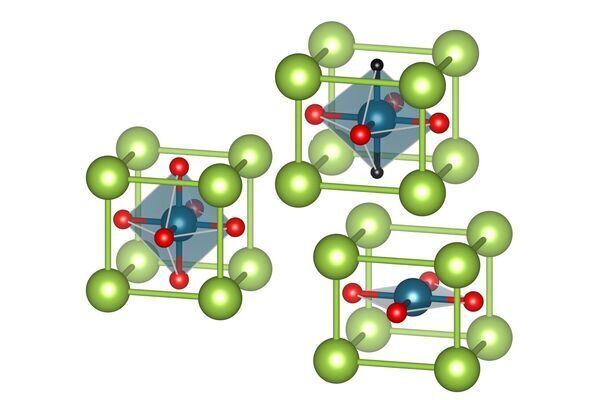
Superconductivity: It’s Hydrogen’s Fault
"Nickel is supposed to herald a new age of superconductivity – but this is proving more difficult than expected. Scientists at TU Wien (Vienna) can now explain why. Last summer, a new age for high-temperature superconductivity was proclaimed - the nickel age. It was discovered that there are promising superconductors in a special class of materials, the so-called nickelates, which can conduct electric current without any resistance even at high temperatures. However, it soon became apparent that these initially spectacular results from Stanford could not be reproduced by other research groups. TU Wien (Vienna) has now found the reason for this: In some nickelates additional hydrogen atoms are incorporated into the material structure." [...]
A Leap in Using Silicon for Battery Anodes
"The same material you'll find at the tip of a pencil—graphite—has long been a key component in today's lithium-ion batteries. As our reliance on these batteries increases, however, graphite-based electrodes are due for an upgrade. For that, scientists are looking to the element at the heart of the digital revolution: silicon. Scientists at the U.S. Department of Energy’s Pacific Northwest National Laboratory have come up with a novel way to use this promising but problematic energy storage ingredient. Silicon, used in computer chips and many other products, is appealing because it can hold 10 times the electrical charge per gram compared to graphite. The trouble is, silicon expands greatly when it encounters lithium, and it is too weak to withstand the pressure of electrode manufacturing." [...]
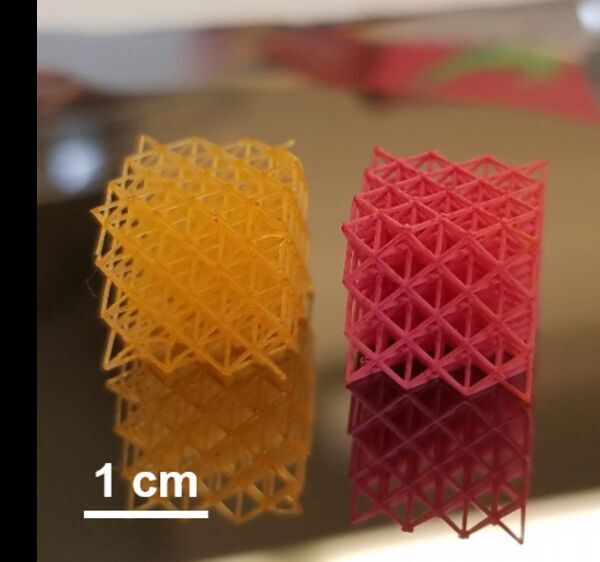
A Great New Way to Paint 3D-Printed Objects
"Rutgers engineers have created a highly effective way to paint complex 3D-printed objects, such as lightweight frames for aircraft and biomedical stents, that could save manufacturers time and money and provide new opportunities to create “smart skins” for printed parts. The findings are published in the journal ACS Applied Materials & Interfaces. Conventional sprays and brushes can’t reach all nooks and crannies in complex 3D-printed objects, but the new technique coats any exposed surface and fosters rapid prototyping. “Our technique is a more efficient way to coat not only conventional objects, but even hydrogel soft robots, and our coatings are robust enough to survive complete immersion in water and repeated swelling and de-swelling by humidity,” said senior author Jonathan P. Singer, an assistant professor in the Department of Mechanical and Aerospace Engineering in the School of Engineering at Rutgers University–New Brunswick. The engineers discovered new capabilities of a technology that creates a fine spray of droplets by applying a voltage to fluid flowing through a nozzle. This technique (electrospray deposition) has been used mainly for analytical chemistry." [...]
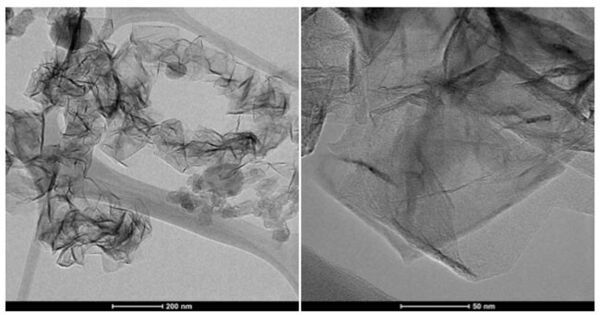
Reducing greenhouse gas emissions using microwave plasma technology
"A multi-disciplinary collaborative relationship, developed between Penn State EMS Energy Institute researchers and a Pittsburgh-based start-up company, may hold the answer to reducing global greenhouse gas emissions while also paving the way to disrupt the chemical and material industries. Since 2015, Randy Vander Wal, professor of energy and mineral engineering and materials science and engineering, and affiliate at the EMS Energy Institute, has been collaborating with H Quest Vanguard on a growing number of projects that use the company’s plasma technology to enable potential new, non-emissive uses of coal and natural gas. “The unique capabilities of Penn State’s Material Characterization Laboratory provide invaluable insights into properties of H Quest’s plasma-produced materials and are crucial to establishing a product fit for commercialization,” said George Skoptsov, H Quest CEO. The collaboration has resulted in five research projects that aim to reinvent coal and natural gas in the 21st century as clean, cost-effective sources of fuels and high-performance materials. Reducing greenhouse gas emissions While the Earth’s climate has changed throughout history, the current scientific consensus is that the present global warming trend is likely the result of human activity, namely emissions of green house gases due to combustion of fossil fuels. Switching to cleaner fuels is recognized as a key component in reducing these emissions." [...]

‘Breathable’ Electronics Pave the Way for More Functional Wearable Tech
"Engineering researchers have created ultrathin, stretchable electronic material that is gas permeable, allowing the material to “breathe.” The material was designed specifically for use in biomedical or wearable technologies, since the gas permeability allows sweat and volatile organic compounds to evaporate away from the skin, making it more comfortable for users – especially for long-term wear. “The gas permeability is the big advance over earlier stretchable electronics,” says Yong Zhu, co-corresponding author of a paper on the work and a professor of mechanical and aerospace engineering at North Carolina State University. “But the method we used for creating the material is also important because it’s a simple process that would be easy to scale up.” Specifically, the researchers used a technique called the breath figure method to create a stretchable polymer film featuring an even distribution of holes. The film is coated by dipping it in a solution that contains silver nanowires. The researchers then heat-press the material to seal the nanowires in place. “The resulting film shows an excellent combination of electric conductivity, optical transmittance and water-vapor permeability,” Zhu says." [...]
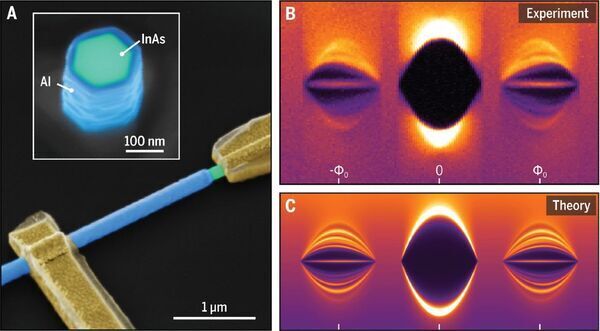
Quantum research unifies two ideas offering an alternative route to topological superconductivity
"Researchers from University of Copenhagen have discovered a new way of developing topological superconductivity that may provide a useful route toward the use of Majorana zero modes as the foundation of qubits for quantum information. A pencil shaped semiconductor, measuring only a few hundred nanometers in diameter, is what researches from the Center for Quantum Devices, Niels Bohr Institute, at University of Copenhagen, in collaboration with Microsoft Quantum researchers, have used to uncover a new route to topological superconductivity and Majorana zero modes in a study recently published in Science. The new route that the researchers discovered uses the phase winding around the circumference of a cylindrical superconductor surrounding a semiconductor, an approach they call “a conceptual breakthrough”. “The result may provide a useful route toward the use of Majorana zero modes as a basis of protected qubits for quantum information. We do not know if these wires themselves will be useful, or if just the ideas will be useful,” says Charles Marcus, Villum Kann Rasmussen Professor at the Niels Bohr Institute and Scientific Director of Microsoft Quantum Lab in Copenhagen. What we have found appears to be a much easier way of creating Majorana zero modes, where you can switch them on and off, and that can make a huge difference." [...]
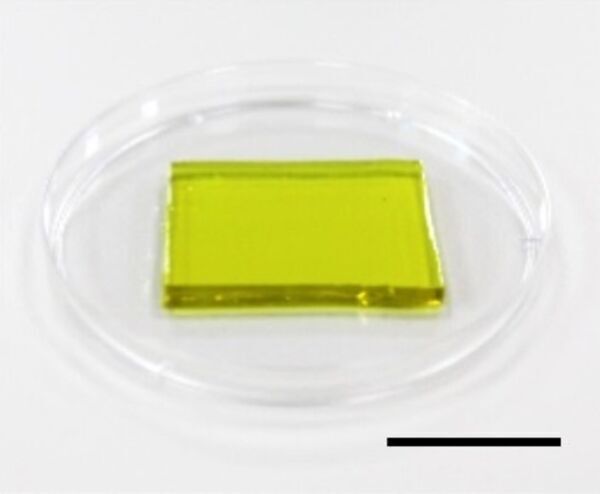
A new way to cool down electronic devices, recover waste heat
"“Thermogalvanic Hydrogel for Synchronous Evaporative Cooling and Low-Grade Heat Energy Harvesting” Nano Letters Using electronic devices for too long can cause them to overheat, which might slow them down, damage their components or even make them explode or catch fire. Now, researchers reporting in ACS’ Nano Letters have developed a hydrogel that can both cool down electronics, such as cell phone batteries, and convert their waste heat into electricity. Some components of electronic devices, including batteries, light-emitting diodes (known as LEDs) and computer microprocessors, generate heat during operation. Overheating can reduce the efficiency, reliability and lifespan of devices, in addition to wasting energy. Xuejiao Hu, Kang Liu, Jun Chen and colleagues wanted to design a smart thermogalvanic hydrogel that could convert waste heat into electricity, while also lowering the temperature of the device. So far, scientists have developed devices that can do one or the other, but not both simultaneously." [...]

‘Strange effect’ raises possibility of smaller, smarter optical filters
"Polarization, in sync. On the macro, everyday level, it reads as an oxymoron. To the University of Nebraska–Lincoln’s Xia Hong and her fellow nanoscientists, though, the apparent contradiction makes a kind of harmonious sense. And it might just spur the development of smaller, more versatile optical filters that are especially adept at playing with a trick of the light. That trick occurs when two packets, or photons, of light strike a material and eject another photon — one with double the energy and half the wavelength — from the material. Because wavelengths differ across the electromagnetic spectrum, the phenomenon can transform incoming infrared waves into waves of blue light, for instance, or that visible light into ultraviolet." [...]
Documentação
A documentação é parte essencial do processo de aprendizagem e a Internet além de artigos interessantes de explorar também tem alguma documentação em formato PDF interessante de ler. Todos os links aqui apresentados são para conteúdo disponibilizado livremente pelo editor do livro.
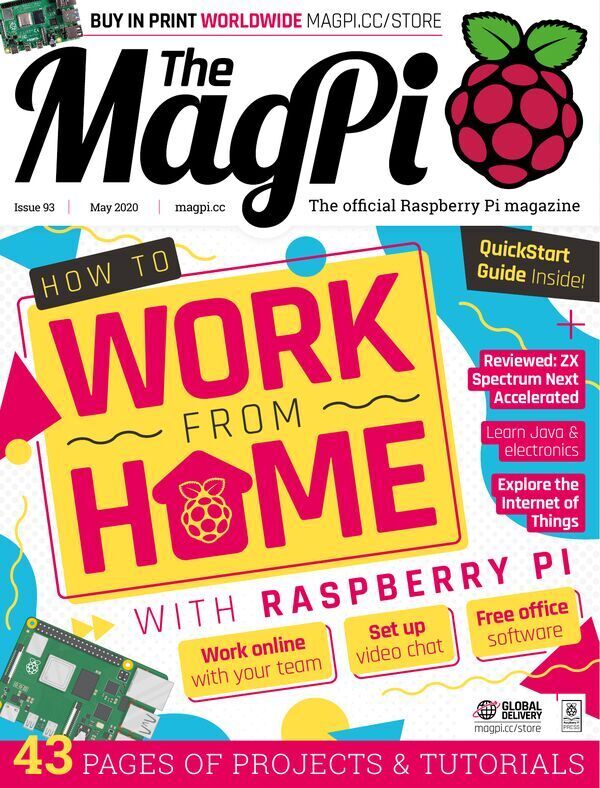
The MagPI 93
"Inside The MagPi magazine #93 Make a Sense HAT rainbow display. Bright colours put a smile on most peoples’ faces. Join the rainbow parade with a light display. Get started with the High Quality Camera. Find out how to set up the new Raspberry Pi camera, connect it, and take your first shots and videos. Make an Etch-A-Sketch." [...]

newelectronics 28 Abril 2020
"New Electronics is a fortnightly magazine focusing on technological innovation, news and the latest developments in the electronics sector. Downloadable as a digital page turner or pdf file, or offered as a hard copy, the New Electronics magazine is available in a format to suit you. " [...]
Projetos Maker
Diversos Projetos interessantes.

Making a wireless joystick
"I always liked the design of the Wii’s Nunchuck controller. But normally you can only use them if they’re physically wired to another device called the Wii Remote. However, with some hardware and software tinkering and time, it’s possible to turn a Nunchuck into a completely stand-alone wireless (PC) joystick. In this post, I’ll briefly go over how I achieved this, as well as share the open-source software and hardware resources I developed along the way. When opening up a $4 Nunchuck-compatible knockoff, it’s easy to spot its two analog potentiometers, the two digital buttons, a MEMS accelerometer chip, and the tiny microprocessor hidden under a black blob. The microprocessor samples all these inputs, and sends out a digital version of this information over the cable that also supplies the device with power." [...]
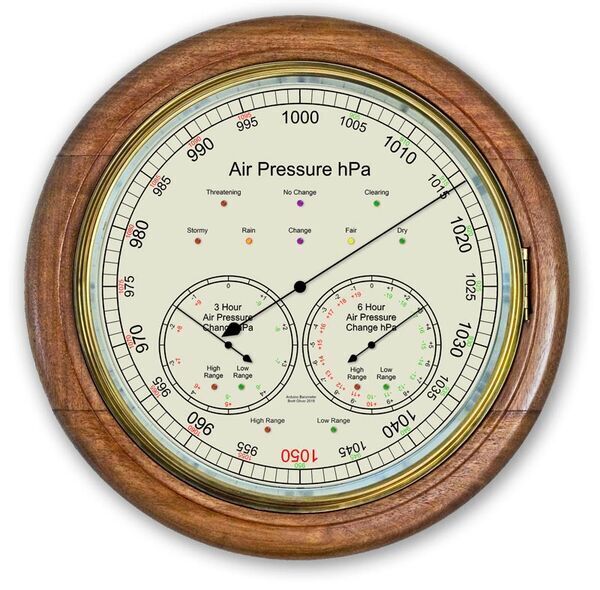
Arduino Barometer
"Using an Arduino UNO and Nano to display Air Pressure on an analogue display using 3 stepper motors Air Pressure in hPa (Hectopascal) is displayed on the large main dial and is updated every 10 minutes. There are 2 secondary dials, one shows the last 6 hour pressure change and the other shows the last 3 hour pressure change. The 3 hour dial has an increased resolution of 0.5 hPa as this is used for weather forecasting. There are LEDs to show when extended range is in use on all three displays and also LEDs to indicate the weather forecast off the 3 hour display. Inside the case two 20x4 LCD screens show info from each of the microprocessors. The main air pressure display and 6 hour display are controlled by a RTC." [...]
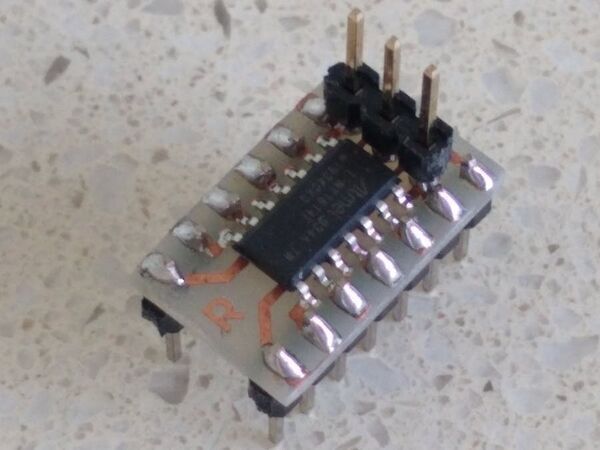
Using the New ATtiny Processors with Arduino IDE
"Use the latest ATtiny processors in the Arduino Environment. These have the memory capacity of ATmega chips in smaller and cheaper packages. You may be familiar with the ATtiny series of microprocessors from Microchip such as the ATtiny85 or ATtiny2313. These chips powered small systems like the Digispark series. Unfortunately, they had limited Flash (usually no more than 8K) and even more limited RAM (usually less than 1K). Now a new series of ATtiny chips are available with more memory and functionality." [...]
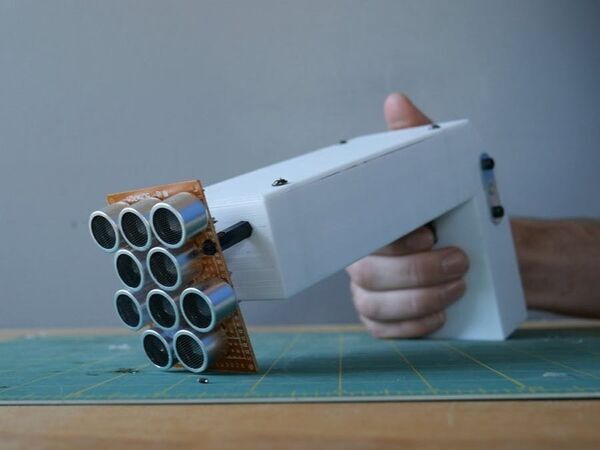
Ultrasonic Sound Gun (Parametric Speaker)
"I built a gun that shoots out a narrow beam of ultrasonic audio. The sound can only be heard by people inside the narrow beam. For this project I built a gun that shoots out a narrow beam of ultrasonic audio. The sound can only be heard by people inside the narrow beam, or through a nearby source when the audio gets demodulated. I was inspired to build this project after watching CodeParades awesome video Turning Sound Into a Laser. I definitely recommend watching his video before you watch mine." [...]
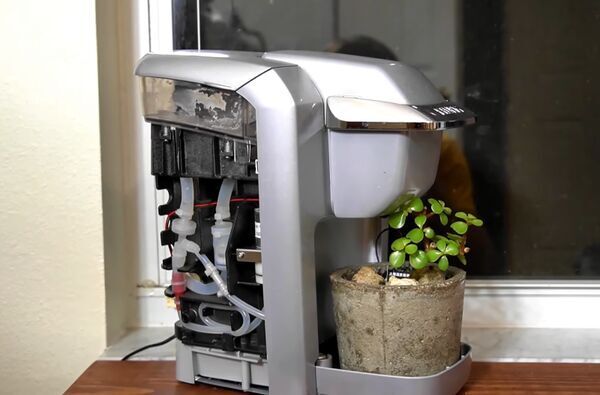
Turn a Keurig Coffee Maker into a Miniature “Raspberry Pi Greenhouse”
"Recently, my wife’s many-years-old Keurig stopped working. Like any engineer/hacker/maker, my first instinct was to poke around, clean out certain parts, etc. to see if I could fix it, and after some time I did get coffee flowing once again. Along the way, however, I noticed that it was rather nasty inside, and that these machines are not made to be easily be taken apart and serviced. Normally, I’d say this is a bad thing, but when dealing with water plus enough electrical current to raise water to a very high temperature, one can understand why it was made in such a way. So, it was a time for a new unit, which actually looks quite nice on our counter now." [...]

Vegetable Assassin
"Vegetable Assassin is a web-based game where players slice virtual vegetables with an internet-connected foam sword. The sword communicates orientation information to the game session using a persistent WebSocket connection to a server, the game is generated and rendered using a 3D client JavaScript library, and game statistics are saved into a server database. Game Details The game draws heavy inspiration from the game Fruit Ninja by Halfbrick Studios. Vegetable Assassin is played by launching the game website from a web browser, which displays various fruit vegetables as they are thrown into the air. Players are tasked with cutting all of them with a foam sword that is tracked by an onboard micro-controller and inertial measurement unit (IMU). But beware!" [...]

DIY Arduino RC Receiver for RC Models and Arduino Projects
"In this tutorial we will learn how to make an Arduino based RC receiver. Since building my DIY Arduino RC transmitter in one of my previous videos, I got a lot of requests from you guys, to make a dedicated receiver for it, so here it is. Now these two devices can easily communicate and we can use them for controlling many things wirelessly. I will explain how everything works through few examples. In the first example we will use this Arduino RC receiver to control a simple car consisting of two DC motors. In the second example I will show you how to control brushless motors and servos, which are common components found in many commercial RC planes, boats, cars and so on." [...]

20 Non-Contact Infrared Reflective Sensor for Line Follower Robots
"This project consists of 20 non-contact infrared reflective sensors and each sensor provides an analog output. QRD114 sensor is the heart of the project which includes Infrared LED and photosensor. The output of each sensor is high and goes low as objects or lines detected. The analog output voltage is proportional to IR reflected back to the sensor. The project has been designed to be used in robotics applications for line follower or multi-object sensor. Sensor requires 5V DC to work, all LEDs have current limiting resistors, each output has a pull resistor, and the normal output of each sensor is high due to the pull-up resistor and goes low as object or line is detected." [...]
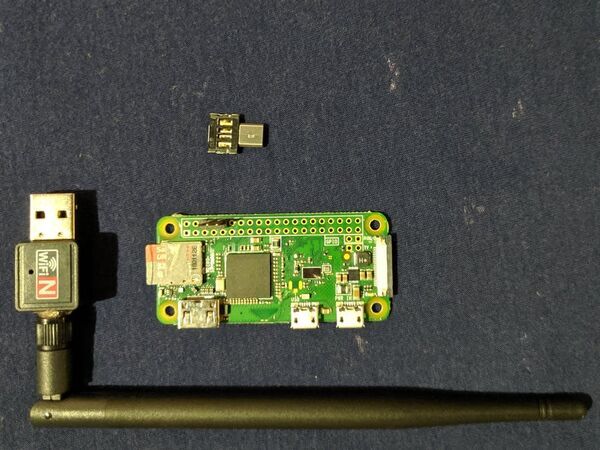
Truly WiFi Extender
"A WiFi repeater built around Raspberry Pi under $10. Introduction Truly WiFi Extender is a WiFi repeater based on Raspberry Pi Zero W. It makes a nice alternative to a commercial WiFi repeater combining low-cost (under 10 USD) and highly customizable software. It can also run some ad-blocking solutions such as pi- hole as well. This project is one of a kind because most of the projects on GitHub demonstrate how to create a wireless AP to share Internet access obtained using Ethernet. Hardware This will run on any version of Raspberry Pi. But make sure to have two wifi adapters." [...]

The NEO430 Processor
"A tiny (really tiny!) msp430-native microcontroller-like processor system written in platform independent VHDL There is a pretty gap in the landscape of open-source soft-core processors between the tiny 8-bit processors and the chunky 32-bit ones. So I decided to fill this gap with a msp430-native 16-bit processor. Introduction The NEO430 is a TI msp430-native tiny microcontroller-like processor system. The system is highly configurable and provides of standard IO and peripheral components. If a certain module is not required at all it can be disabled and thus will not be synthesized." [...]
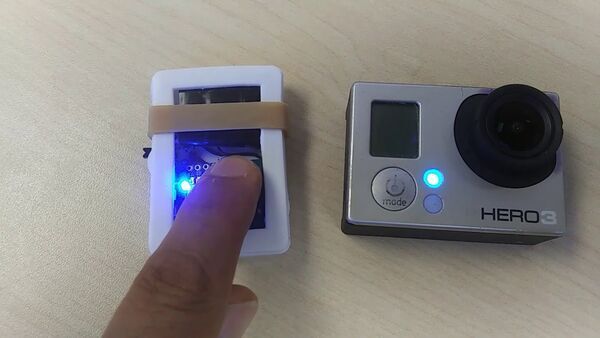
DIY GoPro Wi-Fi Remote Using ESP8266
"So you spent $200 on a GoPro Hero 3 many years ago, but you don't want to spend another 80 bucks for a remote? You came to the right place. Couple of months ago, my friend* Joseph G. Wezensky gave a presentation on MicroPython at a local Meetup. The presentation was great, but I'm not a big fan of MicroPython on micro controllers. At the end of the presentation, he did something unusual, he gave away ESP8266 kits for attendees to apply what they've learned. I didn't want to take a kit because I bought ESP32 few months earlier and it was not very consistent." [...]
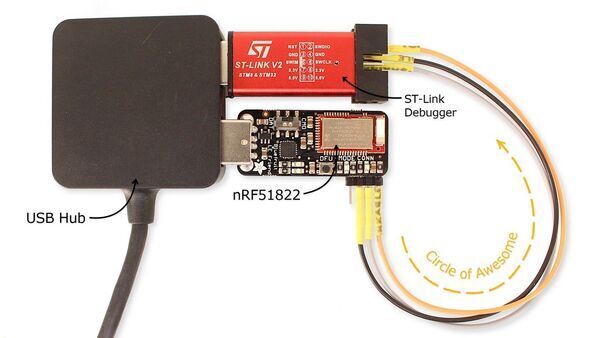
Automated Unlocking of nRF51 Series SoCs with nrfsec
"Recently, while conducting an assessment for a product based on the nRF51822 System on Chip (SoC), I found my target’s debug interface was locked – standard stuff. Reading up on the nRF51 series SoCs revealed that this is how these chips are designed. It’s always possible to perform a full memory recovery/dump, even if read back protection is enabled. I wanted to build on what others have discovered, extending the attack to completely and automatically bypass the memory protection mechanism offered by these SoCs. Beyond reading memory, I also wanted to unlock the device to support interactive debug sessions with my target. This post outlines the theory behind the shortcomings of the debug interface memory read back protection mechanism and introduces a simple tool (nrfsec), to automate the entire process using low-cost debugging hardware." [...]
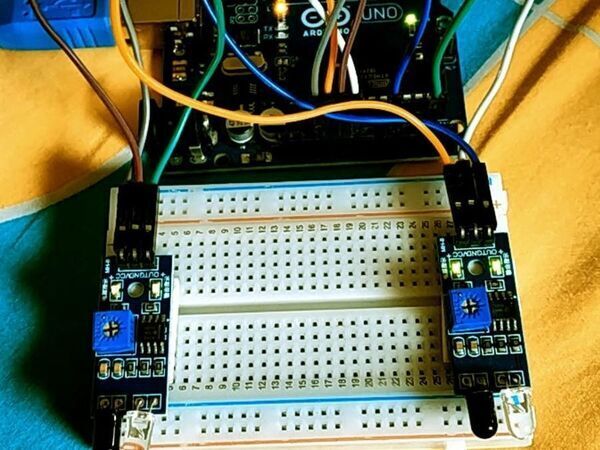
Arduino speed detector
"Super easy project using an arduino uno to detect speed of various moving objects with the help of a pair of IR sensors and get the speed. " [...]
NeoPixel Newton Light Cradle
"A cool Newton's cradle made from ping pong balls containing WS2812B LEDs. This project emulates a Newton's cradle using light to demonstrate the conservation of momentum and energy. The original project was created by TecnoProfesor and can be found at RGB LED Newton's Cradle. My variant uses WS2812B NeoPixel LEDs and an ATtiny1614 microprocessor. It is enclosed in a 3D-printed case. " [...]

A 10-Bit Full Adder
"Now it’s time for something completely different. I know this website is mainly vehicle focused (hence the name “Motors” in the name), but like most people, I have another hobby – electronics. Now, sometimes these two hobbies intertwine, which will be the next post I make, but for this post… they don’t. So, hang in there and automotive content will return soon! Since this post is obscenely long, go ahead and watch this video first to see where we’re headed. Now, before I get too deep into what on Earth you’re looking at in that picture, go to Youtube and watch all of Ben Eater’s videos on building an 8-bit computer from scratch." [...]
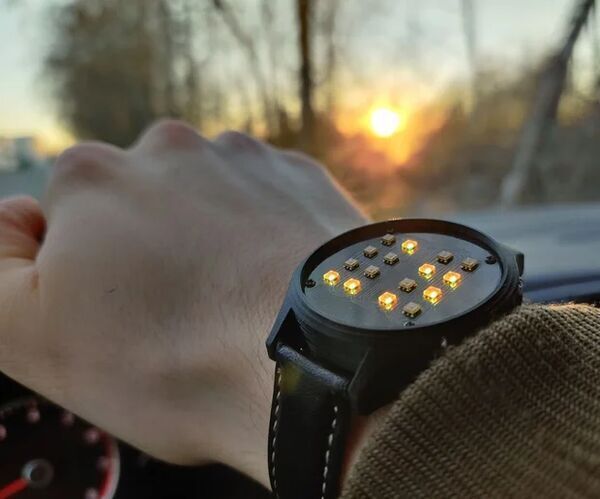
The Ultimate Binary Watch
"I recently got introduced to the concept of binary watches and started doing some research to see if I could build one for myself. However, I was unable to find an existing design that was both functional and stylish at the same time. So, I decided to create my own design completely from scratch! " [...]
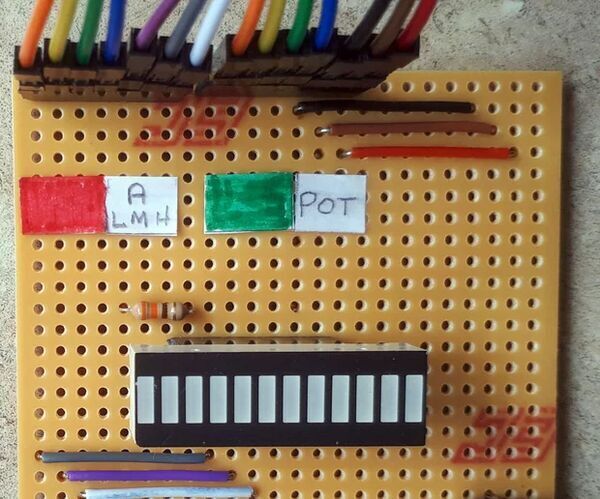
Dual Colour Bar Graph With CircuitPython
"I saw this LED bar-graph on the Pimoroni site and thought it might be an inexpensive and fun project while undertaking covid-19 lockdown. It contains 24 LEDS, a red and a green, in each of its 12 segments, so in theory you should be able to display red, green and yellow. Normally you would expect 2 anodes, one for red and one for green, and 24 cathodes if you were building it out of 24 LEDs. This package only has 14 pins and three pairs of pins are connected internally! How do you drive 24 LEDs with only 11 pins? This looked an even more interesting project." [...]

NTP Synchronised Wordclock
"Sync your clock with a NTP time server so they can check the right time if there has been a black out if your not at home :-) Supplies: Plywood (2 layers) Plexiglas Wemos D1 or Wemos D1 mini pro or Wemos D1 mini Micro usb cable Phone charger Fancy photoframe 168 Pcs WS2812B Ws2812 Led Chips 5V Met Wit/Zwart Pcb Heatsink (10mm * 3 Mm) WS2811 Ic build in Smd 5050 Rgb I went to a so called fabshop to use their lasercutter for the 3 layers. You will also need various tools: drill (+ a selection of drill bits), pliers, clippers(or wire cutters), and a soldering iron(with solder) At first I made my design with a Wemos D1 but I ordered some Wemos D1 mini pro's and some Wemos D1 mini and also on those the clock works perfectly. " [...]
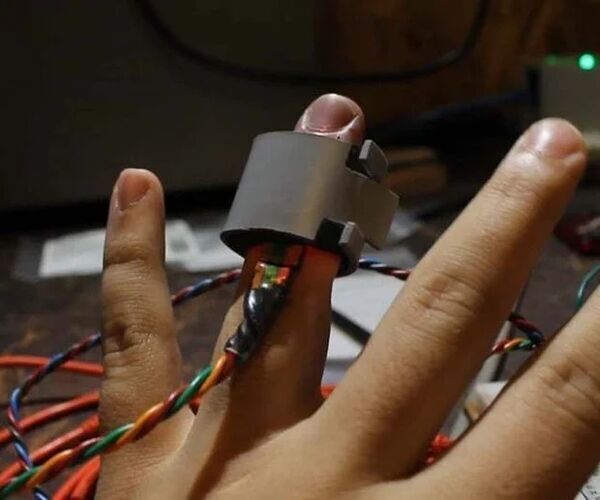
Arduino Pulse Oximeter
"Pulse oximeters are standard instruments for hospital settings. Using the relative absorbances of oxygenated and deoxygenated hemoglobin, these devices determine the percentage of a patient's blood that is oxygenated (a healthy range being 94-98%). This figure can be lifesaving in a clinical setting, as a sudden drop in blood oxygenation indicates a critical medical problem that needs addressed immediately. In this project, we attempt to construct a pulse oximeter using parts that are easy to find online/in a local hardware store. The final product is by no means as accurate as those used in hospitals, but can provide enough information for someone to monitor blood oxygenation over time. The original plan was to make the device fully wearable, but due to factors outside of our control, this wasn't possible in our timescale." [...]

Make Your Own Oscilloscope(Mini DSO) With STC MCU Easily
"This is a simple oscilloscope made with STC MCU. You can use this Mini DSO to observe waveform. Time Interval: 100us-500ms Voltage Range: 0-30V Draw Mode: Vector or Dots. " [...]
Covid-19 Update Tracker Using ESP8266
"This is a project shows the current data of the coronavirus outbreak of various cities of states of India in realtime on OLED display. This Live status tracker helps you monitor realtime covid-19 update of your district. This project is completely based on realtime data collected from API. API provided by covid19india.org. Supplies:ESP8266-01OLED DisplayUSB to TTL converterWiresXamp Software" [...]

1963 Tele-LED Comfort Break Reminder
"This old and unusual dial-less telephone now helps well-being and productivity to co-exist in the home office! Beneath its vintage grille a neopixel ring lights up its 24 LEDs in sequence for an hour, switching to an eye-catching rainbow display when it's time to take a break. Ignore the rainbow and the LED ring starts flashing red, accompanied by a subtle but un-ignorable beep from the phone's original buzzer unit. To cancel the beeping or reset the timer at any time I just need to either press the button on the phone or momentarily lift the handset - both of which force me to get up and walk across the room, then seeing as I'm up anyway I may as well stretch my legs, grab a coffee....you see how it works. The whole thing is powered by a nice old Raspberry Pi 2, using the phone's original switches and buzzer alongside the neopixel ring. It's powered from a USB hub on my work laptop, and boots up automatically when I start up in the morning, so there's nothing to do but reset the timer when I take a break." [...]
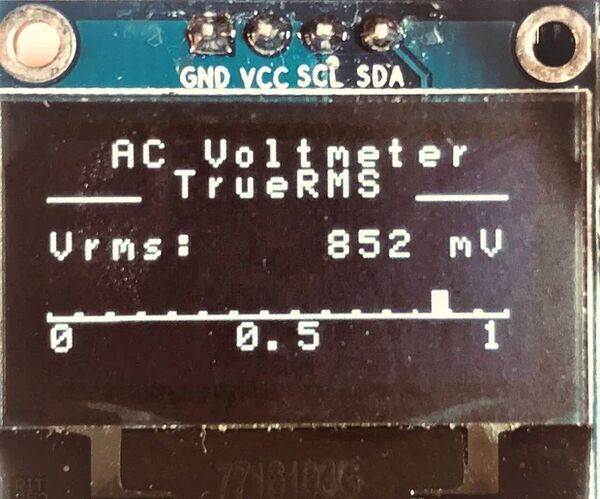
Arduino RMS Meter Module
"This is a small Arduino module for measuring TrueRMS voltage. The meter displays the rms voltage in mV with digits and an analog level scale. The module is intended as a "build in" module for monitoring a signal. " [...]

Retirement Clock / Count Up/Dn Clock
"I had a few of these 8x8 LED dot-matrix displays in the drawer and was thinking about what to do with them. Inspired by other instructables, I got the idea to build a count down/up display to count down to a future date/time and if the target time passed, count up from it. I made this now my retirement clock sitting on the shelf. The idea to put it into a bottle was more of an accident while thinking about a casing. Others put ships into a bottle, why not a clock? I also wanted to make the clock obey daylight saving time and of course remember the settings and time when being unplugged." [...]
NodeMCU and 1.8" SPI ST7735 Display
"I am using the 1.8 color ST7735 TFT display a lot. The reason for that is that this display is very easy to use, it costs less than $5 and it offers color! At the back, the display has an SD card slot.A brief summary of the pins (adapted from Adafruits thorough summary): RST this is the TFT reset pin. Connect to ground to reset the TFT! Its best to have this pin controlled by the library so the display is reset cleanly, but you can also connect it to the Arduino Reset pin, which works for most cases.CS this is the TFT SPI chip select pinD / C this is the TFT SPI data or command selector pinDIN this is the SPI Master Out Slave In pin (MOSI), it is used to send data from the microcontroller to the SD card and / or TFTSCLK this is the SPI clock input pinVcc this is the power pin, connect to 5VDC it has reverse polarity protection but try to wire it right!LED this is the input for the backlight control. Connect to 5VDC to turn on the backlight.GND this is the power and signal ground pinNow that we know what were dealing with its time to start wiring!" [...]
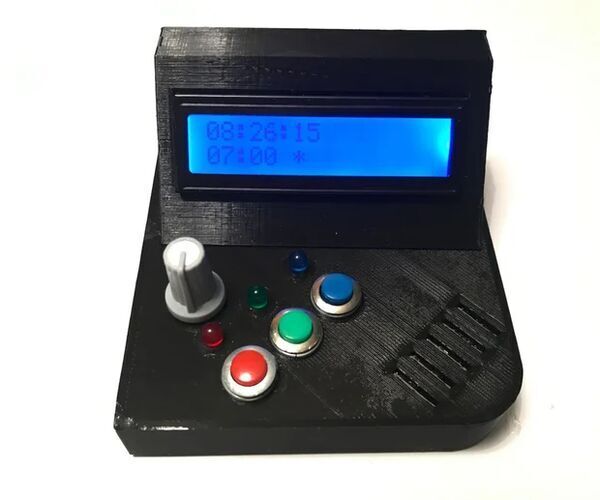
Memory Puzzle Alarm Clock
"This is an Alarm Puzzle Clock which means there is a little memory game you have to solve to stop alarm ringing! As a summary, this clock is for who is being snazzy on mornings. It has 3 LEDs which when you press any of the buttons, the alarm will be silenced and 3 LEDs will give you a random pattern and one minute to enter it. Supplies: - 2 Arduino Pro Mini - Red, green and blue LEDs - Red, green and blue buttons - EC11 Rotary Encoder - Speaker - Some cables, stripboard, headers - 3D printed parts Tools - Soldering Iron and solder - Stripboard" [...]
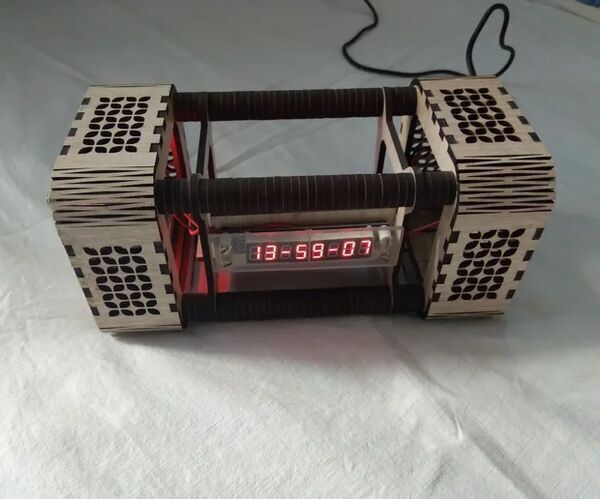
7219 Tube Clock
"This is my first instructable. I got my inspiration for building this clock from https://nixieclocks.shop/product/energy-pillar-iv.... I liked the design of the clock and thought that VFD tube is difficult to find so I took 7219 seven segment 8 digit module available readily for the project . It is just a laser cut design similar to this clock. It is not VFD tube clock, however it looks similar to this. " [...]
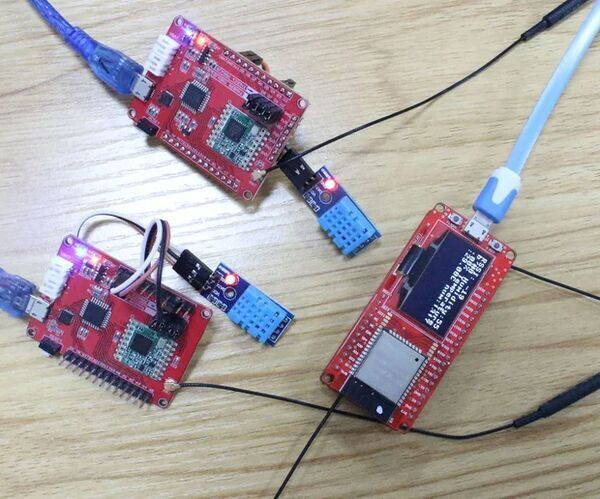
Lora Gateway Based on MicroPython ESP32
"LoRa has been very popular in recent years. The wireless communication module using this technology is usually cheap (using free spectrum), small in size, energy efficient and has a long communication distance, and is mainly used for mutual communication between IoT terminals or data exchange with a host. There are many LoRa modules on the market, such as RFM96W, which is equipped with SX1278 (compatible) chip, which is very small. I use it with MakePython ESP32 as a gateway. Next, I will use two LoRa nodes to send the temperature and humidity data to the gateway, and then upload it to the Internet through the gateway. Here you will learn how to upload remote data of multiple LoRa nodes to the cloud through the gateway." [...]
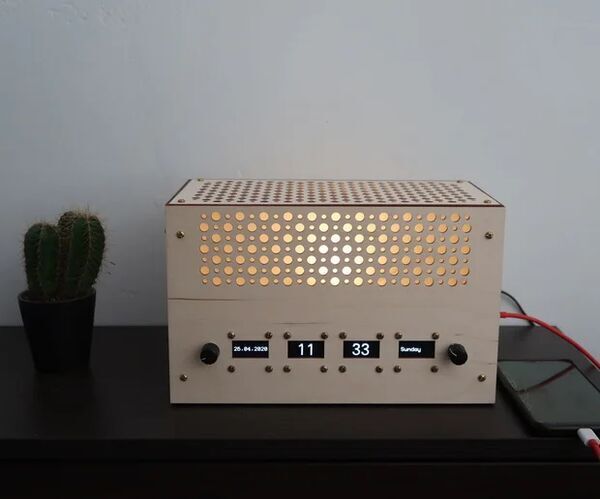
Oled Alarm Clock
"There's a lot of arduino/ESP32 clocks going around, but do they use those nice and crisp OLEDs? I've been experimenting with arduinos and ESP32's for a while now, but I never made it to a finished product. I've made an alarm clock with 4 1.3 inch monochrome OLEDs. The clock also features a dimmable bedside lamp and an USB charging port (no one has spare outlets next to his bed). The OLEDs are dimmable as well, this was added last minute after my project was threatened by my girlfriend. Should dim not be -in girlfriends voice- dim enough, I can also provide a version of the code where 3 displays are powered of between certain hours." [...]
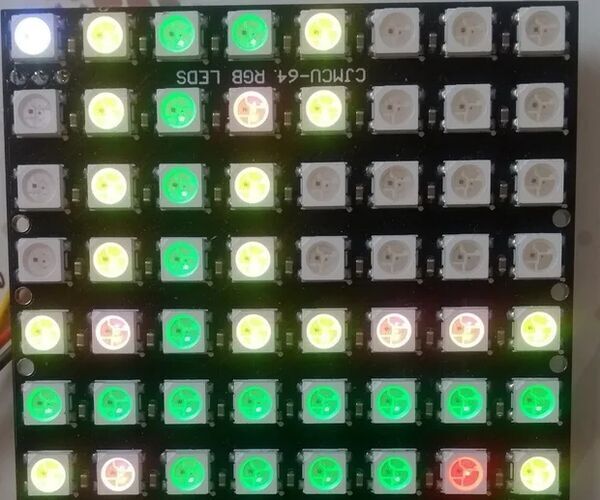
Arduino Minesweeper
"A Fun version of the Minesweeper game, using Arduino Leonardo, 8x8 NeoMatrix Led Array, Button and Joystick Module. Supplies: 1x Arduino Leonardo 1x Neomatrix Led Array 8x8 1x Joystick thumb module 1x Push Button (optional)" [...]

Clock Using Atmega 8
"ATMEGA 8 is one of the cheapest micro controller ,so i decided to make clock using it.The first thing i came across is displaying time hence most general thing is 7 segment display but i can't display all the text expect few ,so i decided to go with 16X2 LCD .Then i came time keeping where recent most of the micro controller offer internal RTC(Real Time Clock) but ATMEGA 8 we don't have internal RTC so i went with external one.Then i came across power the clock ,atmega can run from 1.8v to 5v so i planned to 1s lipo,it worked pretty well...so let start building" [...]

How to Make Buzz Wire Game
"Undoubtedly, Arduino is used in many electronic projects including games. In this project, we have come up with a special game known as buzz wire game or steady hand game. For this project, steel wire is used which you have to transform in a looped shape and a curve one. Make sure the loop is large enough to pass the curve wire and small enough to make this game challenging for you. The aim of this buzz wire game is very simple. Whenever the loop touches the curve wire, a buzzer is used to make a sound." [...]
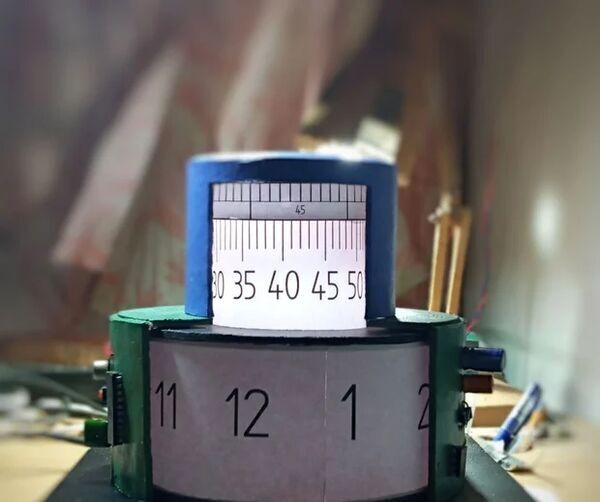
Cylindrical Cyberpunk Clock
"Hello everyone!! Its quarantine everywhere nowhere to go and noting to do.. which means lots of time for doing nothing...Does getting up late and scrolling on social websites,watching movies has become your routine? get off it and try something new ,creative.and make these days interesting.. I had made a similar clock about a few years back,had given it as a present to my cousin.But it didn't had ambience lights and was not so good.I wanted to make it better,but didn't got time to do it. Actually, I got this idea when i saw a analog weighing scale(those spring loaded machines which have rotating circular disc) So I thought this is the right time to make it better. In this clock I have added second hand too.But this time am making it for me.." [...]

Weather Station NODEmcu I2c HD44780
"Do you want to know the current weather? This article will show you how to build a simple weather station with NODEmcu board and HD44780 i2c display. The board uses the ESP8266 chip in order to connect to the internet and we are going to program it using the Arduino IDE. The project gets weather data from the openweathermap.org website and displays some of the data on the display. The display is connected to Nodemcu via the i2c module, so connection is very simple. All we need is the address of module." [...]

3D Printed Infinity Clock
"So the idea with this clock is to make it in the shape of infinity symbol which one side of the shape will be displaying the hour hand and the other one will be displaying the minute. If you have any suggestions or questions for the design or the code you can comment down below Supplies: 2 Stepper motors and drivers (I am using 28BYJ-48 with driver) Microcontroller (I am using Arduino Nano, any other will do) 3D Printer for making the case A small breadboard and jumper wires (You can just solder the wires if you want) A 5V dc adaptor and input jack" [...]
Motion Triggered Neopixel RGB Shoes!
"NeoPixel's are awesome we can control hundreds of lights with 3 wires i.e. 5V, Din & GND and in this tutorial, I'll show how you can make Motion Triggered NeoPixel RGB Shoes! So without any further ado lets get started. Materials: Vibration Sensor Module (One I am using is a DIY version You can check my previous post for that Here) Arduino Nano WS2812B Neopixel LEDs Tools: Soldering Iron Solder wire Helping Hands Hot Glue" [...]

Line Follower Robot Arduino and L293D Shield
"Line Follower is a very simple robot ideal for beginner electronics. The robot travels along the line using the iR sensor. The sensor has two diodes, one diode sends infrared light, the other diode receives the reflected light from the surface. When the infrared rays fall on the white surface, they are reflected back. When infrared light fall a black surface, the light is absorbed by the black surface and no rays are reflected back, so the photodiode does not receive any light. The sensor measures the amount of reflected light and sends the value to the arduino." [...]
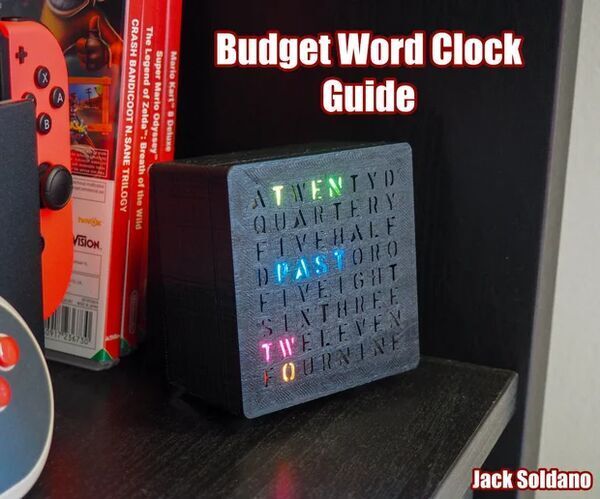
Budget Arduino RGB Word Clock!
"Hello everyone, here is my guide on how to make your own simple & cheap word clock! Tools you will need for this project Soldering Iron & Solder Wires (Ideally at least 3 different colours) 3D Printer (Or access to one, you could also send the .stl files to a print house if you don't have a your own printer) Basic Tools (Screw drivers, wire cutter, file, ect...) All the part you will need to order are covered in the BOM section of this guide! Hope you enjoy, now lets get started! " [...]

MIDI Sonar "Theremin"
"This is a musical instrument which uses two sonar distance sensors to control the pitch and quality of the notes. It's not really a Theremin of course but "Theremin" has become the generic term for instruments played by waving your hands around. It has a built-in MIDI synthesiser, amplifier and speakers. The musical notes are produced by a MIDI chip - the VS1053 - which has 127 voices (i.e. allegedly-different instruments). It has a high degree of polyphony (up to 64) so it can play single notes or chords." [...]
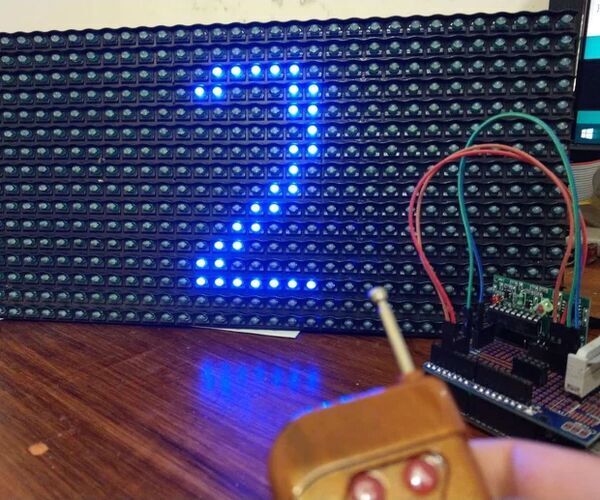
Arduino Wireless RF Remote Counter With Dot Matrix Display
"P10 is one type of Dot Matrix Display that is often used in arduino / microcontroller projects. like running text, score boards, billboards and so on. In this project I will make a display counter that operates using wireless RF remote control. RF module functions as a trigger signal for the Arduino input pin. Has the same process as the push button method" [...]
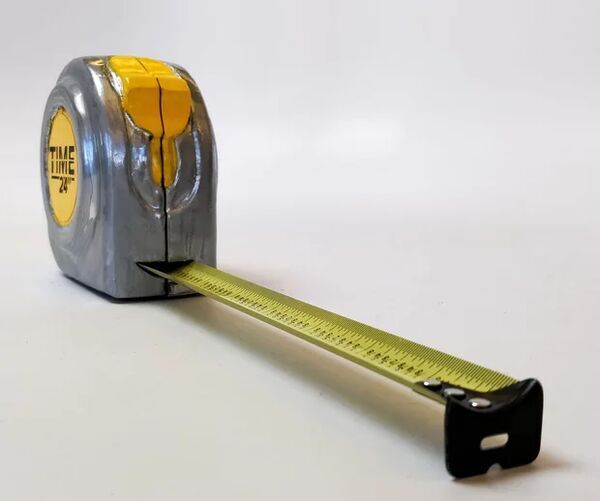
Time Measure (Tape Measure Clock)
"For this project, we (Alex Fiel & Anna Lynton) took an everyday measuring tool and turned it into a clock! The original plan was to motorized an existing tape measure. In making that, we decided it'd be easier to create our own shell to go with the electronics. We motorized a tape measure and programmed it to move over the course of the day to show the time in hours (inches). To keep the whole project looking as best it could, the largest challenge became minifying the electronics and keeping the overall footprint of the device to roughly the size of the real object. Supplies: Electronics: Arduino Nanox1 Adafruit Precision RTC Chipx1 Stepper Motor H-Bridge Chip x1 Stepper Motorx1 12v 1A Adaptor x1 Tiny Limit Switch x1 Boost / Buck Converterx1 6mm (diameter) x 3 mm Magnetsx6 6mm Ball Bearings x(3-10) A couple loose Male / Female Headers Wire Soldering Iron Finishing / Case: 3D-Printer (or access to one) Bondo Auto Body Filler Silver Spraypaint Black Spraypaint Yellow Spraypaint Vinyl Cutter (Or access to one) Autodesk Fusion 360 (if you want to make tweaks to the model)" [...]
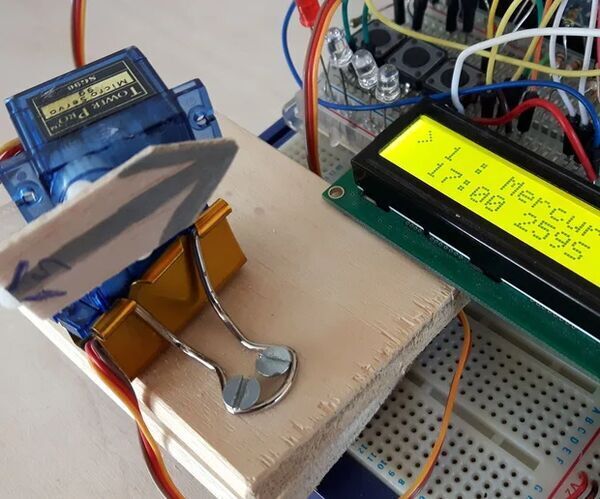
Space Pointer
"This is a space pointer! It lets you select a planet, and time of day, and the arrow will spin around to point to its position in the sky. This is a very simple project, and can be completed in a couple of hours. The computation of the planet positions are done offline and copied into the Arduino source, thereby simplifying the code required. You can see it in action here: Supplies:You need for the physical unit:* Two servo motors (the SG90 micro gear servos are cheap, light, and used here) * Some thin balsa wood (2-6 mm thick) * A binding clip and screws (optional) * Small block of wood, for mounting * Glue * A pen And for the electronics: * Arduino * Three push buttons * One LCD display * A battery connector * A PP3 battery * Lots of wires * A pot (optional, to control LCD brightness)" [...]

Bedside MP3 Alarm Letter Clock
"For this project I wanted to make a convenient and fully functional bedside alarm word clock. My personal prerequisites for a bedside alarm clock are: Readable at any light, while not blinding at night MP3 alarm tunes Attractive and small form factor Snooze function Memory function, so that time, alarm time, ringtone and volume are not lost anytime the power is cut off. Birthday function: At my birthday (and those of my family members) I want to get awakened by "happy birthday" rather than the standard ringtone I could not find any instructable combining all of these; hence this instructable. The clock is build around a 8X8 WS2812B Matrix. Because of the low amount of LED's, not all words can be made up of consecutive letters. Most 8x8 word clocks (like this nice one) solve this by grouping more letters over a single LED, though others have more creative solutions." [...]
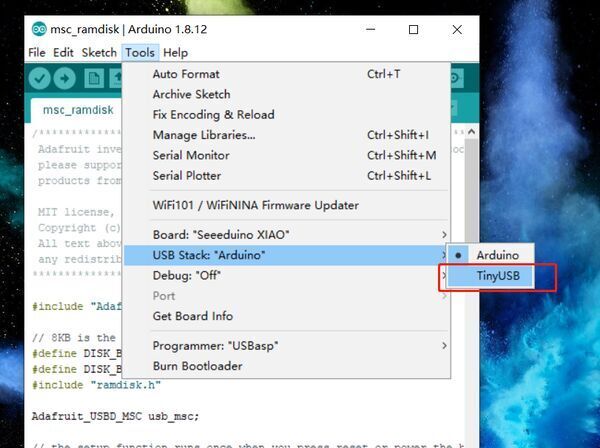
TinyUSB Stack on Seeeduino XIAO
"Unlike the Arduino Uno and Arduino Nano, the Seeeduino XIAO onboard USB is not supported by the common USB-to-serial chip. These chips are usually FT232, CP2102, CH340, and etc. The main chip ATSAMD21 of Seeeduino XIAO is natively supporting the USB protocol stack. This feature means that the USB function can be changed by the code. Other boards with natively USB support: ATMEGA32U4 chip: - Arduino Micro ATSAMD21 - Seeeduino XIAO - Adafruit Feather M0 ATSAMD51 - Wio Terminal - Adafruit Feather M4. With this feature, Seeeduino XIAO is very suitable as the controller of DIY USB devices, such as the DIY mechanical keyboard, it is time to say goodbye to the slow 8-bit ATMEGA32U4 development board." [...]
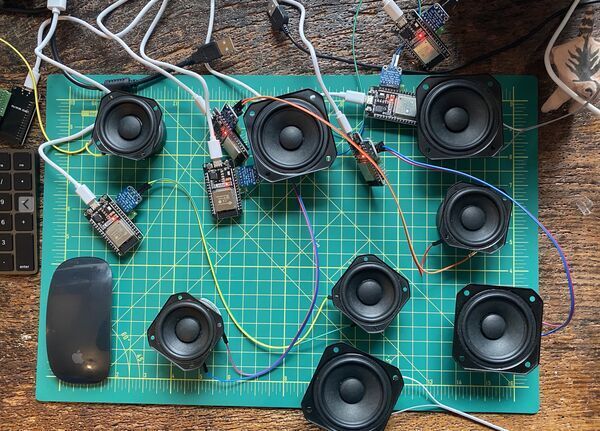
alles
"alles is a many-speaker distributed mesh synthesizer that responds to control signals over WiFi. Each synth supports up to 10 additive sine, saw, pulse/square, noise and triangle oscillators, a Karplus-Strong string implementation, and a full FM stage including support for DX7 patches. They're cheap to make ($7 for the microcontroller, $6 for the amplifier, speakers from $0.50 up depending on quality). And very easy to put together with hookup wire or only a few soldering points. The synthesizers form a mesh and listen to UDP multicast messages. The original idea was to install a bunch of them throughout a space and make a distributed / spatial version of an Alles Machine / AMY additive synthesizer where each speaker represents up to 10 partials, all controlled as a group or individually from a laptop or phone or etc." [...]
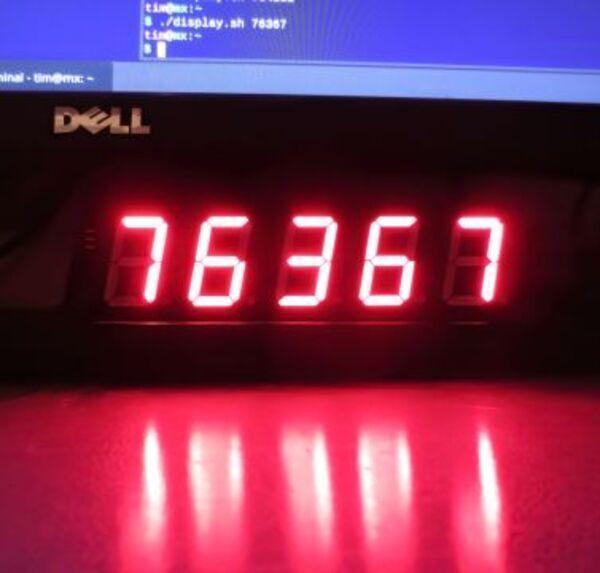
Intelligent 7-Segment Display
"Time for another project with a super-low-cost microcontroller. But what to design? Ever since seeing a project where a $0.03 MCU controls $40 worth of intelligent RGB LEDs, I have been wondering whether this is the right place to use these devices. At this price point, doesn’t it seem to make more sense to dedicate one MCU to one LED each and use it to implement a fancy node-controller? It has always appealed to me to design my own protocol. However, just copying a WS2812 RGB LED or similar seemed to be a bit pointless… After seing this (and also this and this) chainable and adressable 7-Segment display it was clear what to do: Why would you use three WS2811 ICs to control a single 7-segment display when a single microcontroller could do it better at a lower cost?" [...]
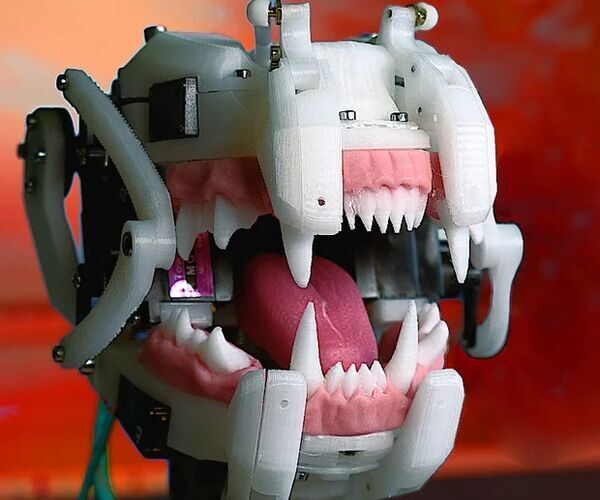
Simple Animatronic Mouth Using 3D Printing, Arduino and Python
"Inspired by Disney's Shaman Animatronic, as well as 3D printed designs by WillettFX and TheDutchEdition, I recently decided to build a 3D printed animatronic mouth design. Although the mechanics of the design are very simplified compared to the other projects I mentioned, I wanted to add a tongue to my design as it's a big component in realistic looking lip-synchronisation. Also, I developed a few different control methods including a program which takes a sentence as an input and converts it into a sequence of visemes (mouth-positions), and another which uses real-time input from a microphone. This project is a nice introduction to animatronic mouths, but there's a lot of room for better control methods and more complex mechanics. I can't wait to see what the community can come up with! Supplies: Mechanics 7x MG90s Micro Servo (2x https://amzn.to/2W3pnUJ) 2x MG996R Servo https://amzn.to/2SfjPFp Various M2 and M3 screws 8x M2 Servo Ball-links: https://amzn.to/2Kq8fDK 4x M2 short pushrod connectors (best just to get M2 screws and saw them up!)" [...]
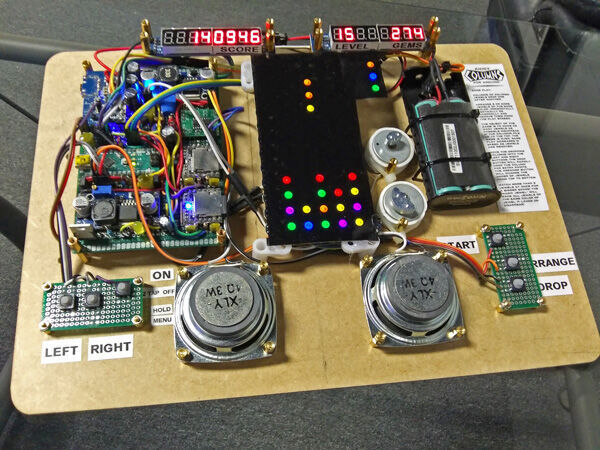
Columns - a Retro Handheld Game for Arduino
"Based on the 1989 Sega(R) arcade and console game Columns which was inspired by Tetris, this is a more modern take on a plausible handheld portable version as would have been envisioned in the late 1980's. My version, employing an Arduino Nano (Or Uno) at its heart, uses a 6 x 13 matrix of addressable RGB LEDs, 2 x 8-LED 7-segment numerical displays, a few buttons, and many other 'bells and whistles' including portable Li-ion power, stereo music and sound effects and even haptic feeback, plus the play of this colorful game is very fast paced and enjoyable! " [...]

PYNQ and Ultra96 Pulse Oximeter
"Implementing a pulse oximeter using PYNQ and the Click HR4 sensor. Introduction Even before the Covid-19 pandemic, when I created my list of projects for the year, I included one which would look at oxygen saturation. Given the current pandemic it has become even more interesting to look at creating such a project. In this project we are going to examine how we can use PYNQ and its high level frameworks to configure and control the Click Heart Rate 4 sensor using the Ultra96. This Heart Rate click will provide us information on the oxygen saturation in the subjects blood using different LED wavelengths. The resulting waveforms can be processed to extract not only the heart rate of the subject but also the oxygen saturation." [...]

First Steps with M5Stick-C
"A wearable, sensor-packed ESP32 IoT device with TFT display. My friend Moheeb sent me this great little M5StickC board, and this thing is just ridiculous! It comes with a built-in rechargeable battery, USB-C connector, Seeed Grove port, two user-programmable buttons, TFT display screen, beautifully labeled breakout header, 6-axis IMU, infrared transmitter, microphone, and much more. I've also had this pulse sensor for ages, but never actually put it in a project. I was eyeing the Micro:bit tutorial, but as cool as it is, it only shows a momentary indicator with each heartbeat. I want to see an actual heart rate number, and after puzzling over it for a while, hadn't come up with any great ways to do that on the Micro:bit's 5x5, single-color LED grid." [...]
That's all Folks!



